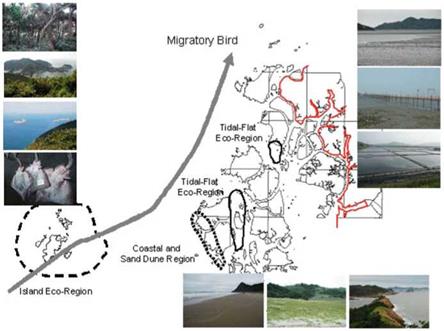In keeping with the Statutory Framework of the World Network of Biosphere Reserves and the Seville Strategy for Biosphere Reserves, the UNESCO Shinan Dadohae Biosphere Reserve (SDBR) can be divided into three functional characteristics, namely, conservation, development, and logistic support. Each of these functional characteristics is now discussed in turn.
9.3.1 Data Collection
A comprehensive ecosystem is made up of various topographies and biological diversity. The core zone of the SDBR includes two islands and two natural monuments that have been designated as the Dadohae Marine National Park. This particular zone is composed of a terrestrial ecosystem, a marine ecosystem, and a tidal flat ecosystem that connects the two previous ecosystems in a comprehensive manner. The area is home to a significant number of animal and plant species that have adjusted to various topographies ranging from abyssal to intertidal and coastal terrestrial ecosystems and also including plains, forests, and mountains.
• The plant species and vegetation found in this area that encompasses everything from a subtropical to a temperate zone can be regarded as the core element of these island and marine ecosystems: geographic isolation results in the territorial ecosystem within the core zone boasting scores of subtropical plants, coniferous trees, and rare plants. As this area exhibits the characteristics of warm-humid oceanic climate, it is home to both temperate deciduous broad-leaved forest and evergreen broad-leaved forest ecosystems, and as such can be regarded as a very important eco-region from an academic standpoint. This area, which belongs to
|
Fig 9.1 The major migration routes of migratory birds within the Shinan Dadohae Biosphere Reserve (SDBR) |
the coast and island axis, represents one of the most important national ecological networks on the Korean peninsula (Yim and Kira 1975, Choung and Hong 2006).
• Numerous kinds of migratory birds as well as animals and plants inhabit the tidal flats (Fig. 9.1): these include various types of marine organisms, such as zoobenthic invertebrate animals and algae. The presence of a highly diverse range of biota that includes halophytes, sand dune plants, and animals in the tidal flats, as well as sand dune insects, helps to form an abundant food web that contributes to heightening the stability and soundness of the ecosystem within the tidelands (Koh 1997, Koh and Shin 1988). Thirteen kinds of birds designated as natural monuments, including the black-faced spoonbill, Egretta eulophote, and Eurasian oystercatcher, have been observed in this tideland area. In addition, 337 kinds of rare migratory birds are known to inhabit or pass through this area. This list includes endangered bird species such as the golden eagle, osprey, and honey buzzard.
• Habitats and migratory homes for animals and plants can be found from the coastal neritic zone to the abyssal zone. A rare type of marine algae, genus Haliptilon, the indigenous species of which is believed to be extinct, inhabits this marine area. In addition, 24 kinds of algae, 117 kinds of invertebrate animals, and 233 kinds of fish also inhabit the area. In his “Jasan eobo” (in Korean), a work that can be regarded as an encyclopedia of marine biology, the seventeenth-century Joseon scholar Jeong Yakjeon (1758-1816), who was an adherent of the Sil-hak (Practical Learning) School, a branch of Confucianism known for its pragmatism, described the area as being home to various kinds of fish and marine products. This situation, he concluded, was the result of the diversity and abundance of marine organisms found in the area. Animal and plant selection of their habitats and migratory homes has been carried out in accordance with the prevailing marine conditions, which are characterized by the presence of tidal flats as well as neritic and abyssal zones and food conditions. As part of efforts to enhance the efficiency with which resources are obtained and develop indigenous natural knowledge and technology that will not alter the balance of resources, local residents have also adjusted to these ecological characteristics.
• The area is also home to an ecological transition zone that connects the sea to the forests. The area’s landscape is continuously connected by the environmental gradient of the ecotone that links together the sea-tidal flats-beaches-sand dunes – vegetation (Hong 2007, Hong and Kim 2007). The presence of various bioorganisms in this area can be regarded as the result of continuous adaptation to the multispectrum. This multispectrum has heightened the conservation value of the area’s landscape diversity and biodiversity.




